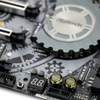Conclusion
Final Words
The ASRock Taichi series has become synonym towards a classic well looking design while remaining affordable. For the X399 series they (currently) do offer the cheapest board, but cheap is still 359 Euros these days. It is as expensive as the Gigabyte X399 Aorus Gaming 7 though. Features wise it's more or less the same for X399 with the uber-enthusiast SKUs making a more significant difference. Performance is slowly crawling upwards a little with the newest BIOSes as motherboard manufacturers are fine tuning and refining their firmwares. I really do like the design of the Taichi, it probably needs to be 50 bucks cheaper though. It shows leading TR performance, that is a fact. So why then cheaper? Well, we do sorely miss a 5 or 10 Gbps Ethernet jack and do find the Wireless AC WIFI implementation very poor. Also the competition offers a 5th x16 slot as well as shielded M2 solutions and more advanced RGB LED systems. Now, stability and compatibility wise we cannot complain, I mean the G.Skill memory 8GB 3200 CL 14 (which can be found under SKU code F4-3200C14D-16GTZR) was running perfect, just flick your XMP mode in the BIOS and you boot at that 3200 MHz CL14 with nice tight timings into Windows problem free. Then there's the heaps of storage options ranging from SATA3 towards and triple M2. And then there is stuff like the four x16 PCIe slots. Also, and this is notable, the Taichi was the motherboard that consumes the smallest amount of power compared to the rest that we reviewed. It's idling at 85 Watts and overall shaves off another 10 maybe 15 Watts in load conditions.
Performance
You have seen the results. Funny story: tests and benchmarks that normally take 5 minutes to finish do that in half or even less the time it usually takes. Many threaded applications will fly in terms of relative performance. And make no mistake, single threaded performance as well is really good as Threadripper can boost towards 4.0 GHz with an extra 200 MHZ XFR allowance as well. You can clock and thus tweak all cores on this proc to 4 GHz as well. Albeit you do need to wonder if that is fair in terms of extra heat levels and power consumption. But sure, if yo want to, you could. Make no mistake, you do not need a 16-core processor, I have stated it many times already, I feel that we all need to move to 6 and 8-core processors as these simply offer a snappier and faster PC eco system with all the things we do simultaneously on a PC these days. But long term a platform like this might last your many MANY years. You have the performance, the threads and let's not forget the connectivity with the many PCIe Gen 3.0 lanes available.
The Experience
With the latest initial BIOS and motherboard we really did not run into any significant issues if at all. The memory compatibility and stability is good. If you pick your memory right, you will not have any issues as the initial Ryzen releases already has removed the launch issues. In the BIOS simply enable the XMP SPD profile and you'll boot straight into Windows with your new timings and frequency. I've mentioned it a couple of times already, but please read up in this article for some good memory recommendations. These memories work on Ryzen, and will work just as well on Threadripper as well. Game performance then, it's fine. Yes you'll be able to perhaps gain 10% more perf at 1080p in a CPU bound situation from a faster clocked Intel counter-part. How important that is to you is totally up-to you. My advice, take the money you save on the AMD platform and invest that in a faster GPU. That's what call a double whammy. Think about it. Stability then, no problems whatsoever. The PC boots at XMP into windows instantly, we didn't have a single crash or weird instability whatsoever.
The Memory
The new AGESA 1006 based BIOSes have improved a lot, Threadripper is starting at AGESA 2006 at launch, the same stuff. 3200 MHz is a non-issue with the right memory, we recommend 2933 MHz or better when you build a gaming rig. Obviously with quad-channel you could go a little slower as you gain more bandwidth. All previously AGESA 1006 and newer firmware approved memories as we have tested should be fine to us. It is however a new platform and chipset, hence please do give AMD and their motherboard partners a little time to iron out any inevitable bugs and launch issues (but we haven't ran into anything significant enough really).
The Power
This processor now fabbed at 14 nm FinFET the TDP sticks to roughly 180 Watts. A full PC at idle will sit in the ~85 Watt range with a dedicated graphics card installed (GeForce GTX 1080 / 16 GB memory / SSD and the motherboard). When we stressed the processors with a Prime 1024M run we reached roughly 260 Watts, that's low enough for what it needs to be. Overall though, this is impressive to see with sixteen CPU cores, especially compared to what we have seen from Intel more recently. When we game we hover at ~320 Watts which is higher then we are used to, but that's the 2nd CPU die, also and obviously that factor is dependant on the type of graphics card you use of course as well as how many CPU cores the game utilizes. So yeah, these are a notch higher, but overall good enough values with this mega-core Threadripper product series.
The Tweak
Anything Ryzen architecture based does to roughly a max of 4 GHz, but will also end there with an allcore tweak. This is the same for Threadripper. Apply a 40x multiplier. Use a voltage offset that gets you close or just at 1.35 volts and you should be able to rock and roll. Be advised though, tweaking creates more heat and thus make sure you have enough cooling. We surely recommend some form of liquid cooling. On the cooling-block / processor surface area coverage we said enough, it's not an issue. None whatsoever. Obviously tweaking also will increase your power consumption (when the PC is stressed), please do keep that in mind. One note here though, tweaking does remain to be a bit of a conundrum. You can achieve an allcore tweak to 4.0 GHz. Intel goes higher in their clocks and often can reach 4.5 to 5 GHz. That's where some residual games perf is found in CPU bound situations. It also would have been nice to see a per core or even per CCX (per 4 cores) tweak. Say four cores at 4200 MHz, four at 4000 MHz and the rest at 3700 MHz. That way you can balance heat and energy consumption better while getting more perf in your main and prioritized threads. The fact that you can clock 16 cores at 4.0 GHz stable at fairly low voltage however is pretty amazing stuff. And that's where we land in the following chapter.
The conclusion
ASRock has a compelling product with the X399 Taichi. However the other brands offer a bit more with M2 shielding, better WIFI implementation, more LEDs and more PCIe slots. Really the limited WIFI module disappointed me the most, and that should not be happening in this price range. See, price wise the Aorus Gaming 7 is at exactly the very same level, that board would get my preference as there it all works fine with a nicer RGB LED implementation and gets five x16 PCIe configuration as well (albeit looks are subjective of course with all the LED hype). The Taichi scores high marks in terms of performance, the latest BIOS squeezes out the last bit of performance and sure, it all feels balanced and refined. We do miss out on 5/10 Gbps Ethernet as well, that makes this board less future-proof. Connectivity wise in terms of your PCIe slots, well it's all plentiful. Tweaking wise the processor is the limit these days, not your motherboard. See, the mobo board can go higher and will facilitate anything the Threadripper processors can do with up-to 3600 MHz clocked on that quad-channel memory as well. However for TR the domain on all cores is roughly 4.0 ~ 4.1 GHz. While 359 Euros is a lot of money, I do say that this board might be worth it. If ASRock could shave off say 50 bucks, this board would have been a massive win. But right now other competing boards offer a bit more for the same kind of money. Aside from these remarks, everything else is lovely. The looks are good, connectivity is plentiful and the performance is well balanced (very good even). We like the fact that this board shows the lowest power consumption of all boards we have tested to date. Overall we can absolutely recommend the X399 Tachi as a very reliable well performing board with a kick-ass UEFI BIOS. A bit of a price reduction however seems to be all it needs to make my personal X399 short-list.
ATH +++
- Hilbert out
- Sign up to receive a notice when we publish a new article
- Or go back to Guru3D's front page.
“A mind needs books as a sword needs a whetstone, if it is to keep its edge.”



